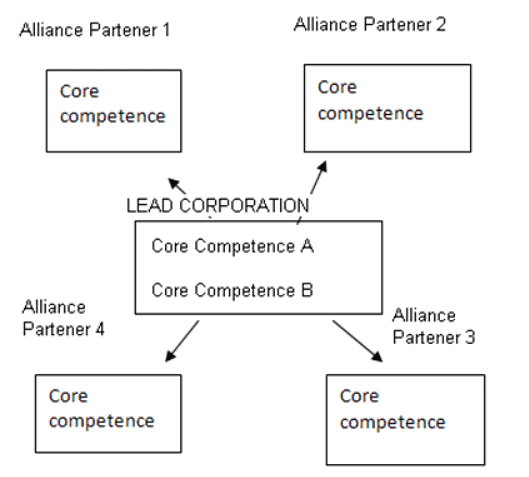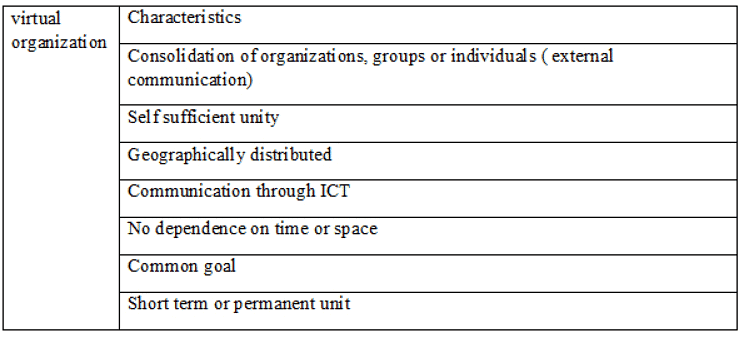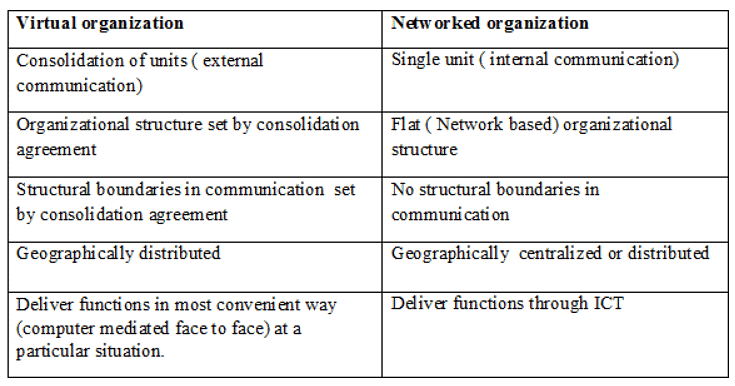Networked and Virtual Organizations | NABARD Grade A & Grade B Preparation - Bank Exams PDF Download
Adapting to Change: The Shift from Traditional to Virtual Organizations
- In the rapidly evolving contemporary business environment, small and medium-sized companies face increasing pressure to transform into virtual organizations. The dynamic and unstable nature of the present situation necessitates frequent changes in organizational structures, prompting companies to continually seek the optimal organizational arrangement. These companies must develop suitable organizational structures and information networks that focus on critical information and resources for strategic and operational decisions.
- The traditional hierarchical model is giving way to more flexible networks, transitioning from centralized to decentralized structures. Management scholars, such as Vetschera (1997), use terms like "VO" (Virtual Organization) and "NO" (Networked Organization) interchangeably to describe this evolving organizational type. Collaborative NO, networked company, networked firm, networked corporation, and networked enterprises are some of the terms associated with NO, while VO is referred to as virtual enterprise, virtual firm, among other names. Both NO and VO represent innovative solutions to the challenges faced by modern management setups.
Network Organizations: Collaborative Dynamics in Contemporary Business
- Network organizations, often comprised of small and medium-sized companies, manage their operations and communication through various channels such as face-to-face interactions, telephone, post, and fax. The core concept of a network involves nodes and links, where nodes can represent individuals, teams, or entire organizations, operating at different levels. This organizational model is observed in various contexts, including distributed geographic teams in large corporations or smaller organizations forming networks to compete against larger counterparts.
- According to Jacobsen and Thorsvik (1998), many organizations, due to limited self-sufficiency, engage in collaborative efforts with other companies to achieve their goals. The ability to establish effective networks through collaboration has become crucial for companies seeking a competitive advantage. In a network organization, individuals hold distinct positions within the organizational hierarchy. Formal communication channels facilitate the transmission of orders from higher levels and the exchange of information across the organization. Work is structured around specific job descriptions located in defined spaces, such as offices in a particular building, street, town, or state, and the reward system is based on longevity.
- Dalsgaard and Bendix (1998) emphasize that in all forms of networks, individuals cannot escape mutual contact, whether positive or negative, as they depend on each other. In management literature, a Network Organization (NO) is characterized as an organization or organizational field where all members are connected to a single electronic network for communication, including non-work-related affairs. Such organizations have communication-rich environments, with information flows transcending traditional intra-company boundaries (Rockart and Short, 1991). Their communication structures are based on electronic networks that allow flexible information flows spanning various groups and organizational boundaries (Miles and Snow 1992).
- Network organizations typically have a computer-mediated communication system that expands through acquisition and is integrated with neighboring organizations in other countries (Lea, 1995). Rockart and Short (1991) exemplify a network organization through shared properties, goals, expertise, work processes, decision-making, prioritization of timing and issues, responsibility, accountability, trust, and recognition and reward.
Characteristics of network organization

- The network structure signifies a flexible organizational framework that enables companies to navigate the challenges of a competitive environment. It fosters cooperative relationships among new associates, and unlike other organizational structures, the boundaries between structural components are not as rigid within the network. The shared use of information infrastructure and networks, which are common property within the network, further fuels this flexible process.
- Virtual organizations have gained significance in the business world due to numerous challenges in managing work processes and practices, including the introduction of new products, globalization, and the internalization of businesses. The evolution of Information and Communication Technology (ICT) has facilitated the decentralization of work, prompting the need for new organizational structures and job contents. Future advancements in mobile and wireless technologies are expected to revolutionize working life by providing increased flexibility in terms of working location. Organizations, both in the private and public sectors, must transform themselves to fully leverage these technologies and thrive in a rapidly changing world. These factors have led to the emergence of numerous virtual organizations.
- Globalization of economies and businesses has further contributed to the rise of enterprises without boundaries, engaging in multi-site work within cross-cultural contexts. To effectively adapt to these changes, businesses need to reorganize themselves along fundamentally new lines (Vartiainen, 1991). Moreover, Jarvenpaa and Leidner (1998) highlighted that as companies expand internationally, face heightened time constraints in product development, and rely on more foreign-based subcontracting labor, virtual organizations provide the flexibility, responsiveness, lower costs, and improved resource utilization required to meet evolving task requirements in a highly disordered and dynamic international business environment.
- Technological advancements in computing and telecommunications have played a pivotal role in enabling virtual organizations to establish and maintain distributed structures, facilitating coordination among individuals working from different locations. Ray Grenier and George Metes identified this shift to a new organizational structure as a response to unprecedented customer expectations, global competition, time constraints, complexity, rapid change, and enhanced technology utilization. They described the virtual model as a leading organization forming coalitions with groups and individuals from various organizations, including customers, competitors, and suppliers. These coalitions, termed virtual organizations, consist of a hybrid of groups and individuals from multiple companies working towards specific objectives, such as the rapid development and marketing of high-quality products or services.
The virtual cooperation. A network of organization working independently to bring product in the market.

- Theoretical investigations have been conducted to define virtual organizations. Ahuja and Carley (1998) define a virtual organization as a geographically distributed entity whose members are connected by a shared long-term interest or goal, coordinating their work through information technology. Other theorists describe virtual organizations as small, core entities that outsource significant business functions. In terms of structure, virtual organizations are highly centralized with minimal or no departmentalization (Robbins, 2001).
- Jackson provided a technical perspective on virtual organizations (1999), where the term "virtuality" originated in information technology to denote memory activated for a specific purpose, making computer memory appear larger than its actual size. Applied to organizations, it signifies structures and processes that exist only when activated, allowing virtual organizations to appear large externally while being compact internally, facilitated by extensive use of computer-mediated networks.
- Some theorists posit that virtual organizations are dynamic networks of nodes (individuals, organizational sub-units, organizations) linked through computer-mediated connections, configured dynamically and specifically for particular issues (Picot et al. in Jackson, 1999). Therefore, virtual organizations are characterized by an ongoing process of determination and reshaping (Barnatt; Davidow and Malone; in Jackson, 1999). Ahuja and Carley (1998), Daniels (1998), and Jarvenpaa and Leidner (1998) emphasize that Information and Communication Technologies (ICT) serve as the crucial "organizational bond" holding the virtual organization together, even when geographically dispersed.
Characteristics of a Virtual Organization
- Virtual organizations share common characteristics such as being driven by specific market opportunities, possessing world-class core competencies, utilizing information networks, having interdependent relationships, and having flexible boundaries. These organizations are shaped by specific market opportunities, and once established, they may engage in new partnerships.
- Each participant in a virtual organization contributes high-level core competencies, creating synergies across various functions and processes. The success of virtual organizations is heavily reliant on advanced information technology, enabling geographically dispersed teams to collaborate through computerized information systems, desktop videoconferencing, combined software, and intranet systems.
- In a virtual organization, members form a network of interdependent relationships, leading to increased dependence and unprecedented levels of trust. Strong interdependencies blur organizational boundaries as competitors, suppliers, and customers enter into collaborative agreements. These evolving relationships necessitate a shift towards new management practices.

Challenges
Virtual organizations present considerable complexities and pose significant challenges, including strategic planning dilemmas, boundary blurring, loss of control, and the need for new managerial skills. Strategic planning in virtual organizations involves identifying effective combinations of core competencies, and collaboration requires a shared vision among participating firms, leading to strong interdependencies and challenges in defining organizational boundaries. Managing these boundaries efficiently becomes crucial, and coordinating mechanisms play a vital role in supporting these loosely connected firms.
The loss of control over certain operations in virtual structures necessitates effective communication, organization, and trust among collaborators, demanding a new set of managerial skills. Workers experience increased uncertainty regarding organizational membership, job roles, career paths, and superior-subordinate relationships, prompting a need for a reevaluation of rewards, benefits, employee development, recruitment, and other employee-related issues. Developing leaders capable of creating and maintaining virtual organizations is a challenging task.
Management scholar Les Pang outlines several best practices derived from successful implementations of virtual organizations:
- Promote cooperation, trust, and empowerment.
- Ensure each collaborator contributes a distinct strength or asset.
- Guarantee that skills and competencies are complementary, avoiding overlap.
- Ensure partners are flexible.
- Clearly define and specify roles and deliverables in contractual agreements.
- Where possible, retain some face-to-face interaction.
- Provide critical training for team success.
- Recognize that team development takes time.
- Ensure compatible and reliable technology.
- Offer competent and available technical assistance.
Future of Virtual Organizations
- The current business environment demands companies to be more flexible, agile, and efficient in delivering products and services promptly. Traditional organizational forms are often deemed inadequate for meeting the demands of this fast-paced environment.
- Emerging structures like virtual organizations are being explored by organizational leaders as they seek new strategies to navigate the challenges of the twenty-first century. These innovative structures will necessitate managers and leaders to address emerging challenges in an environment marked by increased ambiguity and instability.
- In the scientific literature review, it is evident that researchers distinguish between Virtual Organizations (VO) and Network Organizations (NO). Although both types of organizations are closely associated with computer-mediated relationship processes, they exhibit distinct features driven by unique factors.

The Use of Virtual Organizations
- Virtual organizations have gained legal recognition in numerous countries globally, with initiatives like UK Gateway exemplifying efforts to facilitate online transactions for citizens and businesses. The global trend emphasizes digitizing all government services, and the UK is on track to achieve this objective.
- Currently, 57 percent of the United Kingdom's 60 million citizens and 98 percent of its three million businesses have internet access. Various organizations and government agencies have embraced the concept of virtual organizations.
Conclusion
In summary, the evolving business landscape features two prominent organizational types. A virtual organization represents an autonomous, geographically dispersed collaboration of organizations, groups, or individuals that utilize Information and Communication Technology (ICT) to communicate seamlessly and achieve shared objectives, whether for a short period or permanently. Conversely, a networked organization is a flexible entity with a network-based structure, where employees communicate through ICT without hindrances of structure, time, or space while performing their duties. While entities within a network organization are typically legally independent, there are exceptions. Differentiating factors include the role of the network in communication and function delivery processes and the number of organizational units involved.
|
847 videos|1297 docs|420 tests
|
FAQs on Networked and Virtual Organizations - NABARD Grade A & Grade B Preparation - Bank Exams
| 1. What is a virtual organization? |  |
| 2. What are the characteristics of a network organization? |  |
| 3. What are the challenges of virtual organizations? |  |
| 4. What is the future of virtual organizations? |  |
| 5. How are virtual organizations used in contemporary business? |  |















